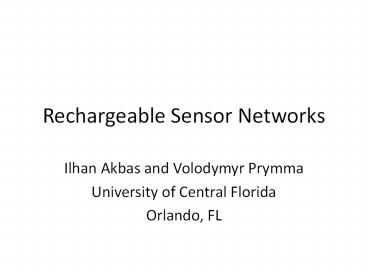Rechargeable Sensor Networks PowerPoint PPT Presentation
Title: Rechargeable Sensor Networks
1
Rechargeable Sensor Networks
- Ilhan Akbas and Volodymyr Prymma
- University of Central Florida
- Orlando, FL
2
Overview
- Introduction
- Rechargeable Sensor Network
- Testing Scenarios
- Simulation Results
- Demonstration
- Conclusion
3
Introduction
- Miniaturization
- Smaller sensors
- Lower energy consumption
- Micro-sensors
- Very small devices
- Limited functionality/resources
- Rechargeable
4
Introduction
- Applications
- Various military operations
- Natural disaster monitoring/recovery
- Rescue operations
- Simple environment monitoring
- Need for autonomous architecture
5
Introduction
- ANSWER
- AutoNomouS netWorked sEnsoR system
- Developed by Dr. Olariou et al.
- Self-organizing architecture
- Our contribution
- Addition of rechargeable sensors
- Performance evaluation rechargeable vs.
non-rechargeable
6
Rechargeable Sensor Network
- ANSWER Architecture
- Large number of micro-sensors
- A number of AFNs
- Single mobile node
- Unique coordinate system
7
Rechargeable Sensor Network
- Dynamic coordinate system
- Concentric coronas
- Centered at training agent (TA)
- Equiangular wedges
- Self-organization
- Easy clustering
8
Rechargeable Sensor Network
Dynamic coordinate system
9
Rechargeable Sensor Network
- Communication schemes
10
Rechargeable Sensor Network
- Coloring scheme
- Coronas are further subdivided
- Each node has a specific color
- Colors are assigned based on signal strength
- Allows for activation of nodes in subsets
11
Rechargeable Sensor Network
- Coloring scheme
12
Rechargeable Sensor Network
- Micro-sensor states
13
Testing Scenarios
- Scenario 1
- One stationary threat node
- Positioned directly in the path of mobile node
- 200 micro-sensor nodes
- 6 AFNs
- Mobile node
- Move from top left corner to bottom right
14
Testing Scenarios
- Scenario 2
- Ten stationary threat nodes
- Positioned randomly in the vicinity of the
network - 200 micro-sensor nodes
- 6 AFNs
- Mobile node
- Move from top left corner to bottom right
15
Testing Scenarios
- Scenario 3
- One mobile threat node
- Set to move from top right corner to bottom left
- Intersects the path of mobile node
- 200 micro-sensor nodes
- 6 AFNs
- Mobile node
- Move from top left corner to bottom right
16
Testing Scenarios
- Scenario 4
- Ten mobile threat nodes
- Set to move randomly
- 200 micro-sensor nodes
- 6 AFNs
- Mobile node
- Move from top left corner to bottom right
17
Simulation Results
- Metrics
- Avg. failures vs. number of nodes
- Avg. failures vs. mobility
- Avg. energy consumption vs. number of nodes
- Avg. energy consumption vs. mobility
- Comparisons
- Rechargeable vs. non-rechargeable nodes
18
Simulation Results
- Avg. failures vs. number of nodes
19
Simulation Results
- Avg. failures vs. mobility
20
Simulation Results
- Avg. energy consumption vs. number of nodes
21
Simulation Results
- Avg. energy consumption vs. mobility
22
Demonstration
- YAES Screenshot
23
Conclusion
- ANSWER
- Provides reliable architecture
- Better results with dense network
- All scenarios had similar results
- Rechargeable vs. Non-Rechargeable
- Rechargeable implementation has better
performance - Fewer failures
- Less energy consumption
24
Questions?

